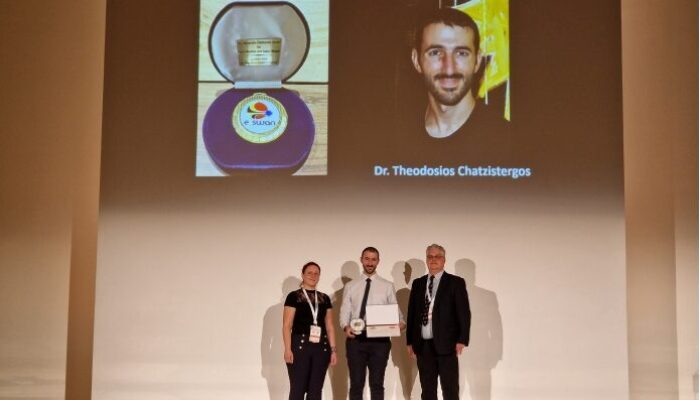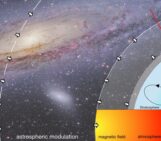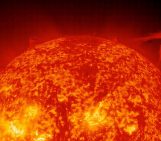
1. Congratulations on receiving the e-SWAN Alexander Chizhevsky Medal for outstanding contributions to space weather and space climate. How does this recognition reflect your work and impact in the field?
Thank you! I am deeply honored to receive this award, which recognizes not just my work but the collective efforts of many collaborators over the years. My research has focused on reconstructing historical solar activity, an essential endeavor for understanding how solar variability influences Earth’s climate and space weather. This recognition underscores the vital role of historical solar observations in modern science and highlights the importance of sustaining long-term observational programs as well as preserving the existing ones.
This recognition underscores the vital role of historical solar observations in modern science and highlights the importance of sustaining long-term observational programs as well as preserving the existing ones.
2. What inspired you to pursue research in space weather and space climate? Were there specific mentors or moments that influenced your journey?
From a young age, I was captivated by physics, especially astronomy and astrophysics, thanks in large part to my high school physics tutor, Nikos Chatzinikolaou. I vividly remember the excitement of regularly checking NASA’s Astronomy Picture of the Day, eager to read about the breathtaking, out-of-this-world phenomena. This passion shaped my academic journey, leading me to pursue a BSc in physics and an MSc in astronomy and astrophysics, where I took courses relevant to the Sun whenever possible. Although my BSc and MSc projects focused on different topics, my interest in solar physics never faded. This is why I had applied for a PhD position at Max Planck Institute for Solar System Research (https://www.mps.mpg.de/). There, my curiosity was truly ignited when I first met Dr. Natalie A. Krivova and Prof. Sami K. Solanki, who introduced me to their research, particularly the project that would ultimately become the focus of my PhD.
3. Could you summarize the key achievements that earned you this award? What aspects of your research do you find most exciting?
One of my key contributions has been the development of methods to analyze historical solar observations, enabling us to extract more accurate information about solar variability than was previously possible. This includes improvements in the recalibration of sunspot data dating back to the 1600s, as well as the calibration of observations in the Ca II K and Hα lines extending into the late 20th century. This work has significantly refined long-term solar activity reconstructions, particularly sunspot number series and solar irradiance variations, which are crucial for understanding the Sun’s influence on Earth’s climate.
I find it especially exciting to work with historical data, as it feels that it essentially gives them a ‘second life’. These observations, which once had limited applications when first collected, now offer new potential. With our current understanding of solar physics and modern computational techniques, we can extract critical information from them that was previously not realised, which I find very exciting. Furthermore, I find it fascinating that the nature of this work is highly interdisciplinary, requiring collaboration among experts from diverse fields.
I find it especially exciting to work with historical data, as it feels that it essentially gives them a ‘second life’.
4. Space weather research often requires collaboration across disciplines. Have you worked on interdisciplinary projects, and do you see potential for expanding these efforts?
Absolutely. Space weather and space climate research are inherently interdisciplinary, bringing together solar physics, geophysics, atmospheric science, and even historical studies. For example, analyzing historical sunspot records would be impossible without the expertise of historians. Similarly, understanding extreme space weather events, such as our work on the 1872 event (https://dx.doi.org/10.3847/1538-4357/acc6cc), requires both historical insights and terrestrial geomagnetic data. Our reconstructions of solar irradiance variations play a crucial role in studying the Sun’s influence on Earth’s climate and are thus provided to CMIP7 (Coupled Model Intercomparison Project) (https://wcrp-cmip.org/cmip-phases/cmip7/), ensuring accessibility for climate scientists as they prepare for the next IPCC (Intergovernmental Panel on Climate Change) report (https://www.ipcc.ch/). Furthermore, understanding solar activity on timescales beyond the reach of direct observations is only possible through cosmogenic radioisotope measurements, such as 10Be in ice cores and 14C in tree rings. These isotopes are produced in the upper atmosphere when cosmic rays interact with atmospheric molecules. Their journey from production to deposition involves complex atmospheric transport processes, including stratosphere-troposphere exchange, circulation patterns, and precipitation dynamics. Specialists are needed not only to measure these isotopes in their respective reservoirs, ice cores, and tree rings but also to study the atmospheric and geophysical processes that influence their transport and deposition. Additionally, understanding geomagnetic variations is crucial, as changes in Earth’s magnetic field modulate the cosmic ray flux and, consequently, the production of these isotopes. Strengthening these interdisciplinary ties is vital for advancing our understanding of past solar activity and variability as well as solar-terrestrial interactions.
5. How do you see your research evolving over the next decade? Are there major challenges or opportunities you anticipate?
As is often the case in research, answering one question inevitably leads to many more. While we have made significant progress in analyzing historical ground-based observations, already resulting in improved reconstructions of past irradiance variations, this work has also uncovered previously unrecognized sources of uncertainty in historical data. Many challenges remain, but for most of them, we have promising ideas on how to address them, particularly by leveraging insights from modern cutting-edge observations.
Over the next decade, the wealth of data provided by various cutting-edge missions will present tremendous opportunities to refine our understanding of solar activity and further improve our interpretation of historical records. The unique observations from the third flight of the balloon-based Sunrise mission, for instance, will be pivotal in our work with Ca II K observations, contributing directly to more precise past irradiance reconstructions.
However, alongside these opportunities, there are also major challenges. One of the most pressing concerns is ensuring the continuity of ground-based solar observations, particularly in the Ca II K line. Long-term records from ground-based sites remain indispensable for studying solar variability across extended timescales. Without sustained efforts to maintain these observational programs, we risk losing critical data that serve as the foundation for long-term solar reconstructions. Another significant challenge is the recovery of the remaining unexplored historical archives. Over time, these invaluable records deteriorate, risking permanent loss. Additionally, as researchers who once worked with these data retire and institutions change function or close down, many historical observations become forgotten or neglected. Even when archives are identified, the lack of funding for digitization presents a major obstacle. For instance, the Kenwood Ca II K archive in the U.S.A., which dates back to 1892, remains in limbo, waiting to be preserved while facing the risk of further irreparable damage. Without urgent efforts to recover and digitize such records, we may lose critical pieces of our solar history forever.
Without sustained efforts to maintain these observational programs, we risk losing critical data that serve as the foundation for long-term solar reconstructions.
6. With advancements in AI, machine learning, and space-based observations, how do you think new technologies will shape the future of solar-terrestrial research?
Advancements in AI and machine learning are already transforming the analysis of large solar datasets, from detecting and classifying sunspots to improving space weather predictions. These technologies enable the recognition of complex patterns in vast amounts of data, unlocking new possibilities in solar physics. Machine learning is particularly promising for historical data analysis, allowing us to extract more information from records that we could not fully interpret before or that would be extremely time-consuming otherwise. However, it is important to note that these new techniques will need thorough validation and testing before they can be fully relied upon, which presents one of the challenges ahead.
Meanwhile, cutting-edge space-based observations, such as high-resolution solar imaging and expanded heliospheric monitoring, are providing unprecedented data that will refine theoretical models and deepen our understanding of solar activity. Missions like the Parker Solar Probe(https://science.nasa.gov/mission/parker-solar-probe/),Solar Orbiter (https://www.esa.int/Science_Exploration/Space_Science/Solar_Orbiter),Aditya-L1(https://www.isro.gov.in/Aditya_L1.html), and the third flight of the balloon-based Sunrise mission (https://www.mps.mpg.de/solar-physics/sunrise) are already contributing invaluable insights, which will also play a pivotal role in guiding our interpretation of historical solar records. Looking ahead, missions like Vigil (https://www.esa.int/Space_Safety/Vigil) will further advance our ability to detect solar storms and coronal mass ejections (CMEs) early, making them invaluable for improving space weather forecasting and mitigating its impact on Earth. We are currently in an exciting era, with numerous fascinating solar missions both operating and on the horizon.
Machine learning is particularly promising for historical data analysis, allowing us to extract more information from records that we could not fully interpret before or that would be extremely time-consuming otherwise.
7. Early-career scientists often face unique challenges in securing funding, networking, and balancing research priorities. What strategies have helped you navigate these challenges?
I am not sure I am the best person to answer this as I am still navigating these challenges myself. However, one piece of advice I can offer is to take every networking opportunity. Engaging with senior scientists, as well as fellow early-career researchers, at conferences and meetings can be invaluable. These discussions often spark new ideas and potential collaborations that can shape future projects. It is also crucial to gain experience working with diverse research groups. Exposure to different perspectives and approaches helps develop both scientific and professional skills.
When it comes to funding, it is important to remember that rejections are a normal part of the process, even though they are often not openly discussed. It is essential not to get discouraged but to keep refining and improving your proposals, learning from each experience, and persevering in the face of setbacks.
It is essential not to get discouraged but to keep refining and improving your proposals, learning from each experience, and persevering in the face of setbacks.
8. Public engagement and education are important in raising awareness about space weather impacts. Do you participate in outreach activities, and what methods have been most effective for you?
Yes, I believe public engagement is a vital aspect of scientific work. In our technology-driven society, it is crucial to provide credible information about space weather and its potential impacts. As space weather can have significant effects on technology and infrastructure, effectively communicating these issues to a broader audience has never been more important. Given that my work focuses more on space climate, the challenge shifts more towards addressing our understanding of long-term solar activity and solar-terrestrial relations, specifically, how the Sun influences Earth’s system and climate. This is also becoming pressing now due to the worsening climate change situation. Unfortunately, misinformation and disinformation on these topics are widespread, especially on social media, making it essential for scientists to provide accurate and accessible knowledge to counter the noise. I have actively participated in outreach activities, including public events at the research institutes where I have worked, as well as social media discussions on solar physics and space climate. Engaging with the public is a learning process for me, and I hesitate to claim that I have found effective ways to communicate these complex topics. I curate a ‘starter pack’ on the Bluesky social media platform featuring scientists whose research focuses on solar physics, space weather, and space climate. Those interested in these topics will hopefully find engaging and insightful posts from the experts included in the list.
My favorite and most rewarding public outreach activity so far has been developing a citizen science project on the Zooniverse platform called ‘Sunspot Detectives’ (https://www.zooniverse.org/projects/teolixx/sunspot-detectives/) . We invited participants to help count sunspots in historical drawings from the 1800s. To engage a broad audience, we designed the project to be approachable, providing clear background information, motivation, and easy-to-follow tasks. The response has been overwhelmingly positive so far, particularly from young people and students. Many became intrigued by solar observations and, through the platform, had the opportunity to learn more and directly interact with us to ask questions.
In our technology-driven society, it is crucial to provide credible information about space weather and its potential impacts.
Dr. Theodosios Chatzistergos is a postdoctoral researcher at the Max Planck Institute for Solar System Research. He earned his Ph.D. from the Georg-August-Universität Göttingen, specializing in the analysis of historical solar observations. His research focuses on understanding past solar magnetism, reconstructing long-term solar activity and irradiance variations to better understand their influence on Earth. For his research, he received the SCOSTEP Distinguished Young Scientist Award and the Alexander Chizhevsky Medal.




